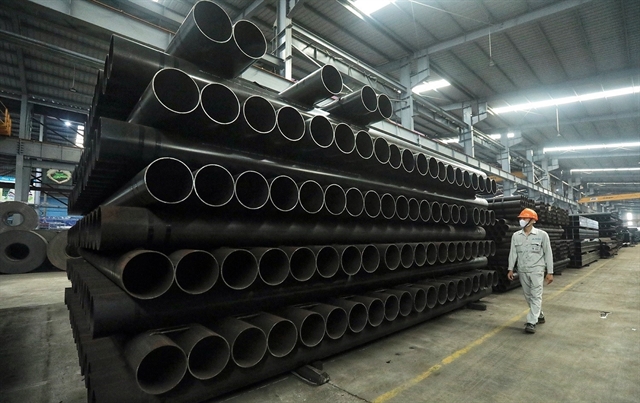 Economy
Economy

 |
| Export steel pipes at Hoà Phát Group's factory. In 2023, Việt Nam exported over 2.5 million tonnes of steel to the EU market, nearly doubling from 2022. — VNA/VNS Photo |
HÀ NỘI — To promote steel exports to the European Union (EU) market, Việt Nam's steel manufacturers need to optimise technology, save energy, and carry out product quality standards of the EU, according to Đỗ Nam Bình, head of Minerals and Metallurgy Division, Department of Industry, the Ministry of Industry and Trade (MoIT).
Việt Nam has exported steel products to more than 30 markets in the world, with about 25-30 per cent of its steel exports going to the EU market.
In 2023, Việt Nam exported over 2.5 million tonnes of steel to the EU market, nearly doubling from 2022. Since the Free Trade Agreement between Việt Nam and the EU (EVFTA) that took effect in August 2020, Việt Nam has continuously expanded its market share in the EU, making it one of the main export markets of Vietnamese steel.
However, from mid-2023, especially this year, Việt Nam's steel export to the EU market has faced many challenges.
Phạm Công Thảo, deputy general director of Việt Nam Steel Corporation (VNSteel), said that export volume of Vietnamese steel to the EU accounted for 23 per cent of total exports in 2023. However, from mid-2023, exports to this market have faced two major barriers, which are safeguard measures and the carbon border adjustment mechanism (CBAM).
He said CBAM will aim to impose a carbon tax on all goods imported into EU countries, based on the intensity of greenhouse gas emissions in the production process in the host country.
According to CBAM, in phase 1, the manufacturers of steel products for export, including Việt Nam, must declare their emission levels. In the next phases, they must have CBAM emission certificates from 2026. Buying this certificate will increase production costs, leading to difficulty in price competition. So, businesses must plan to reduce carbon emissions in production Thảo said.
To meet CBAM regulations, Bình also said the steel manufacturers must continue to comply with regulations at the Law on Environmental Protection, Decree 06/2022/NĐ-CP and Decision 01/2022/QĐ-TTg, the National Strategy on Climate Change and Việt Nam's commitments at COP26.
At the same time, Việt Nam needs to have a set of product quality standards according to regulations on goods quality management.
Đinh Quốc Thái, vice chairman and general secretary of the Việt Nam Steel Association, said Việt Nam's steel manufacturing enterprises have been improving production technology to reduce raw material and energy consumption to reduce greenhouse gas emissions.
By 2035, they will gradually use green energy such as rooftop energy and renewable energy for production, as well as gradually applying a number of new technologies to reduce emissions.
Another barrier is that the EU continues to maintain safeguard measures on steel imported into the EU until June 30, 2024.
To avoid safeguard duties, Việt Nam will have to maintain the export volume at below 3 per cent of the total EU import turnover for each type of steel product. If the export volume exceeds the quota, the import tax for the excess is 25 per cent.
Therefore, the Việt Nam Steel Association recommends the Government have policies encouraging steel manufacturers to upgrade production techniques and technology to reduce energy consumption and carbon emissions.
It also proposes that the Government continue to support businesses by issuing trade remedy measures on the domestic market to limit cheap and poor-quality steel.
According to the association, the steel industry is likely to recover slightly in 2024 with an increase of 7 per cent to 21.7 million tonnes in steel consumption and nearly 29 million tonnes in steel production. — VNS